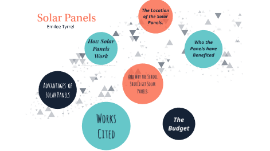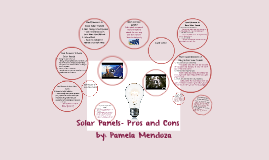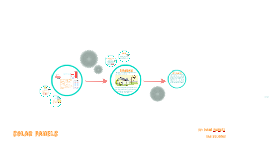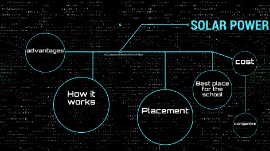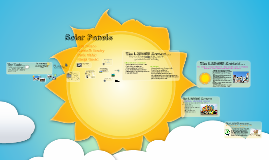Solar Panel Presentation
Transcript: Solar Panels Emilee Tyrrel Advantages of Solar Panels Pollution free and causes no greenhouse gases to be let into the air. In the end it will save money, and and you can get a return on investment. And there is no maintenance and can last up to at least 30 years. Advantages of Solar Panels: Want to know a useful way to recycle your Christmas tree? Some zoos take donated Christmas trees and use them as food for the animals. How Solar Panels Work How Solar Panels Work: So solar panels work a little like this, so for the panels to work the photovoltaic cells need to create an electric current, in order to do that it needs a negative and positive charge. When the photons of light hit the solar panel, and set an electron free, it will push that electric current created to the silicon junction. And then there is also metal conductive plates in the sides of the photovoltaic cell to collect the electron and turn it into any type of electricity. How Solar Panels Work: DC and AC: AC Circuit: The AC stands for "Alternating Current", they named it this because the current alternates between +V and -V, 60 times a second. DC Circuit: The DC circuit doesn't alternate, and it stays at the same voltage the whole time. And the DC uses a magnet to attract the arc of the circuit. DC/AC Converter: The DC/AC converter is for when, lets say a home usually uses AC power, but a special appliance needs DC power. So there is an attachment to put on the outlet called a "rectifier". To convert the AC power to DC power, or it can also be called an "inverter". Photovoltaic: Direct conversion of light into electricity. It works like this: Some materials have a property known as photoelectric effect, this causes them to absorb photons of light and let out electrons. When the electrons are taken, it gives off electric currents. That can be then used for electricity. How Solar Panels Work: How Solar Panels Work: Where do People Place Solar Panels?: Most people place solar panels where it is very sunny. And most important they have to be facing the south, and without doing that there will be no benefits of having the solar panels. But you can put solar panels anywhere, but usually on rooftops and on the ground, it just depends on the location you are at. The Location of the Solar Panels. The Location of Where I would put the Solar Panels: The location that I would put my solar panels would be on top of the high school. I would do this because, it is the tallest building out of the three schools, and because it is the school that get most of the sun. I would have them facing the south, so towards the football fields, and I would have them at a diagonal. This option would be the best because in the end the schools would be saving lots of money, and for all of the electricity the schools use, this would benefit the budget the most. The Location: I would put the solar panels right here, so they could have the best spot to use all of the suns energy. Who the Panels have Benefited The Businesses that have used Solar Panels: The Apple Store Starbucks And Ikea A solar installer: Which makes around $40,000 a year Jobs that you could have related to solar panels and renewable energy: A Wind Turbine Technician: Which makes around $54,000 a year Energy Efficiency Specialist: Which makes around $70,000 a year The Budget for the Solar Panels: The Budget The Simple Budget for the Solar Panels: When Would the Solar Panels Start to Pay for Themselves? As the bill gets lower, the savings get larger! First of all in the end the school will be benefiting from it, and on average a school pours about $6 billion a year for electricity. If the school purchased solar panels it would cost a large amount in the beginning, but then in the end the school would be gaining money and not loosing $6 billion a year. So with the money that is gained from using the solar panels could go towards new upgrades, and needed things to better the students education. So North Polk why waste your money on electricity? Look outside, there is a power source right in front of you! Just get solar panels and gain money....What are you waiting for? Get the solar panels! Your loosing money as we speak! And Why the School Should get Solar Panels: Works Cited Works Cited






